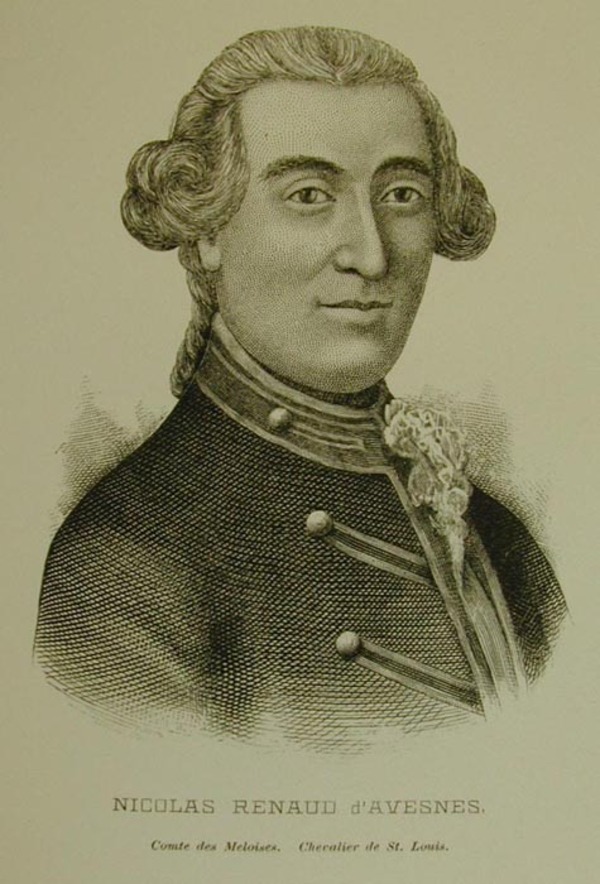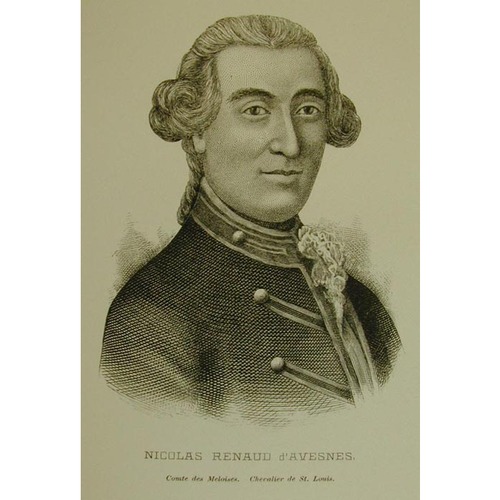
Source: Courtesy of Wikimedia Commons
RENAUD D’AVÈNE DES MÉLOIZES, NICOLAS-MARIE, officer in the colonial regular troops, seigneur; b. 21 Jan. 1696 at Quebec, son of François-Marie Renaud d’Avène* de Desmeloizes and Françoise-Thérèse Dupont de Neuville; d. 4 July 1743 at Quebec.
Nicolas-Marie Renaud d’Avène Des Méloizes’s father, who had come to New France in 1685, was from a distinguished épée family in Nivernais (France). His mother was the eldest daughter of Nicolas Dupont* de Neuville, a councillor and seigneur. Through her he inherited the seigneury of Neuville near Montreal, which his son Nicolas* sold in the 1760s for 45,000 livres. It was his grandfather, Dupont, moreover, who helped launch his military career in 1714 by petitioning Governor Rigaud* de Vaudreuil on his behalf for a commission in the troops. On 1 July 1715 he received the expectancy of an ensigncy and on 27 April 1716 he was appointed ensign on the active list. His marriage, on 19 April 1722, to Angélique, daughter of René-Louis Chartier* de Lotbinière and widow of Jean-François Martin* de Lino, helped to solidify his position in the colonial élite. He used his position, moreover, to obtain leaves of absence from the colonial governors to travel to the French court in search of greater honours. In 1724 he returned after one such junket with the rank of lieutenant, and after carrying the Canadian dispatches to France in 1732 he was promoted captain on 1 April 1733.
During this latter stay in France, Des Méloizes became interested in the manufacture of roofing tile. He was aware of the great need in the towns of New France, where fire was a serious hazard, for a fireproof covering to replace the cedar boards normally employed for roofing. He was probably aware, too, that a recent attempt to solve the problem by quarrying slate at Grand Étang in the Gaspé had failed miserably [see Michel Sarrazin*]. In 1732 he presented a memoir to the minister of Marine, Maurepas, which argued that tile would be an ideal alternative to slate, for both technical and economic reasons. In the memoir he offered to begin manufacturing tile provided the king would lend him 6,000 livres. Maurepas, recalling perhaps that another officer, Gaspard Adhémar de Lantagnac, had established a tile furnace one league below Quebec in 1728 only to abandon it a year later, refused to involve the king until the enterprise showed some initial success. When Governor Beauharnois and Intendant Hocquart* heard of the project, however, they gave Des Méloizes strong support. In fact, Hocquart took the unusual step of recommending him for a seat on the Conseil Supérieur, pointing out that he possessed rare business talents. Maurepas refused to appoint a military officer to the council, but he did authorize Hocquart, on 27 April 1734, to advance Des Méloizes the 6,000 livres in Canadian card money.
Even with this loan, however, Des Méloizes faced formidable obstacles. Because there were no skilled tile workers in New France, he was forced to arrange in 1733 for several to be sent from France the following year. When they did not arrive, he contracted with Jean Le Brun, a tile-maker from Dieppe, to come on a merchant vessel in 1735. But when Le Brun also failed to appear, he used a worker from among the indentured servants arriving at Quebec in 1735 to supervise the baking. Two years had been lost and he still did not have the skilled labour he required.
In 1735 Hocquart placed 3,500 of the 4,000 tiles produced that year on a government warehouse for a two-year test of their durability under winter conditions. He reported that Des Méloizes had only borrowed 2,500 livres of the authorized loan since he did not wish to incur the expense of re-establishing Lantagnac’s furnace until the results of the test were known. An inspection in 1736 revealed that only one per cent of the tiles had broken and this failure was apparently caused by a minor error in baking. By 1737, however, ice had destroyed over 200 tiles and Des Méloizes, thoroughly discouraged, offered to pay back his loan and abandon the enterprise. Hocquart’s insistence that the problem lay with the mortar used to put on the tile and that it could be solved by using nails instead finally persuaded him to make a second two-year trial. Although it proved successful, Des Méloizes had lost his resolve. After obtaining a three-year extension for the repayment of his loan in 1740, he withdrew from the business. The tile works were taken over, in 1741, by Barthélemy Cotton*, receiver of the Compagnie des Indes, but he was forced to close it down during the crop failure of 1743. When Des Méloizes died on 4 July 1743, his loan was still unpaid.
In many ways Des Méloizes’s failure typified the problems of industrial entrepreneurship in New France. He was clearly no bourgeois, lacking both the financial resources and the speculative spirit to succeed in an ambitious industrial undertaking. More important, however, the colony lacked the capital, labour, and technical and climatic conditions to operate such an industry profitably. The prospect of a large local market, the king’s financial assistance, the cooperation of colonial officials, and his own ties to the merchant community were not enough to overcome these basic drawbacks. In the end, Des Méloizes’s name was distinguished in Canadian history not for his entrepreneurship but because his daughter, Angélique*, who married Michel-Jean-Hugues Péan* on 3 Jan. 1746, became the paramour of François Bigot*.
AN, Col., D2C, 222/2; E, 126. ANQ, Greffe de Jacques Barbel, 18 avril 1722. Documents relating to Canadian currency during the French period (Shortt), I, 680, 682, 684, 686. PAC Report, 1886, cxiv, cxxiv, cxxvii; 1904, app.K. Le Jeune, Dictionnaire. P.-G. Roy, Inv. concessions, II, 24–27; Inv. jug. et délib., 1717–1760. J.-N. Fauteux, Essai sur l’industrie, I, 160–69. Nish, Les bourgeois-gentilshommes. P.-É. Renaud, Les origines économiques du Canada; l’œuvre de la France (Mamers, France, 1928), 187. P.-G. Roy, “La famille Renaud d’Avène des Méloizes, BRH, XIII (1907), 171–78.
Cite This Article
Donald J. Horton, “RENAUD D’AVÈNE DES MÉLOIZES, NICOLAS-MARIE,” in Dictionary of Canadian Biography, vol. 3, University of Toronto/Université Laval, 2003–, accessed December 31, 2025, https://www.biographi.ca/en/bio/renaud_d_avene_des_meloizes_nicolas_marie_3E.html.
The citation above shows the format for footnotes and endnotes according to the Chicago manual of style (16th edition). Information to be used in other citation formats:
| Permalink: | https://www.biographi.ca/en/bio/renaud_d_avene_des_meloizes_nicolas_marie_3E.html |
| Author of Article: | Donald J. Horton |
| Title of Article: | RENAUD D’AVÈNE DES MÉLOIZES, NICOLAS-MARIE |
| Publication Name: | Dictionary of Canadian Biography, vol. 3 |
| Publisher: | University of Toronto/Université Laval |
| Year of publication: | 1974 |
| Year of revision: | 1974 |
| Access Date: | December 31, 2025 |



